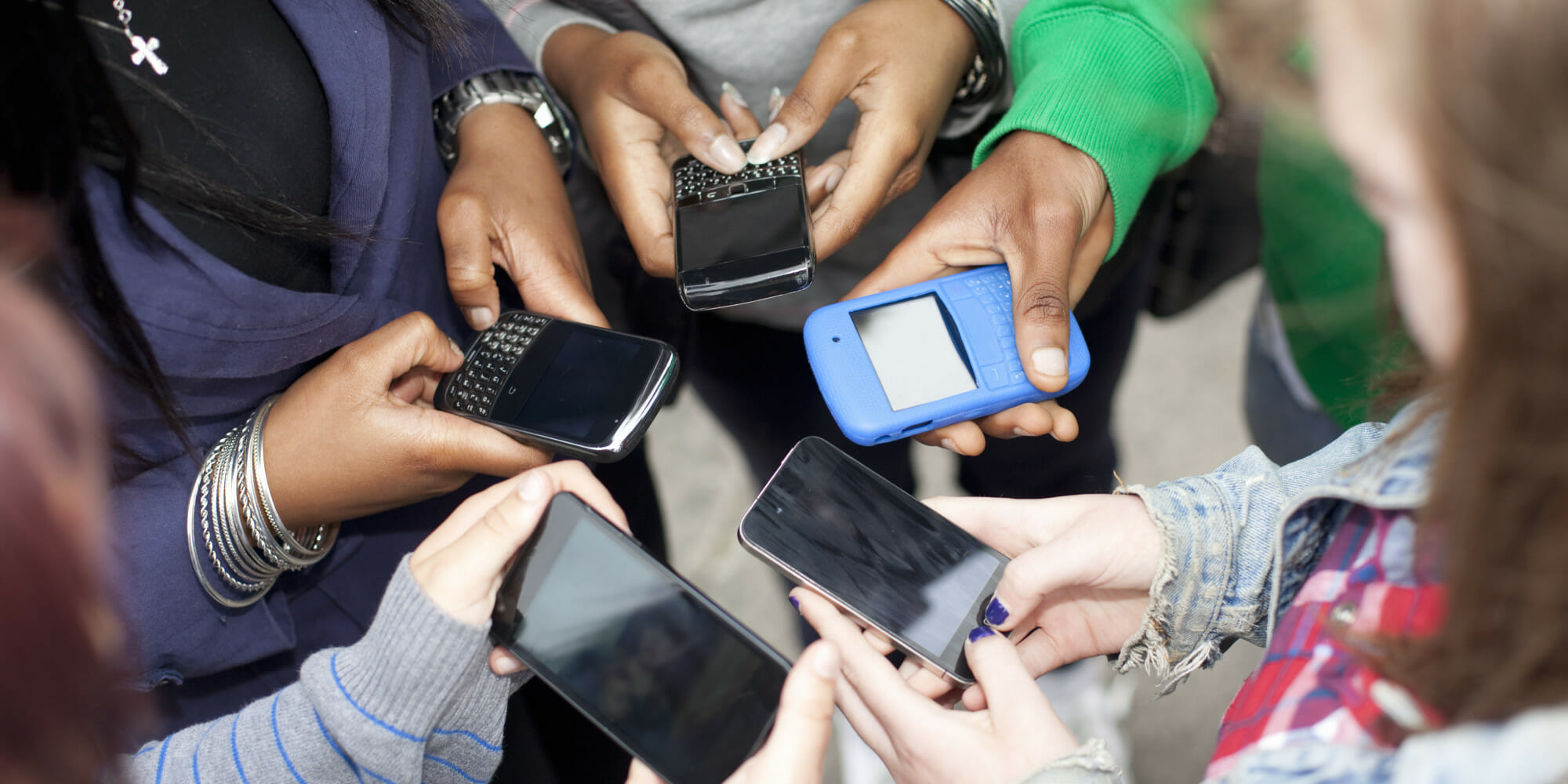Our teenage years are confusing enough, especially in the beginning, as we start to discover new things about ourselves, how to talk to boys without sounding like a complete idiot (I’m still working on this one) and wrestle with self-esteem and body insecurities, just to name a few….
When I was 13, social media platforms were still a few years away. No one had a cell phone, let alone one with a camera. Interactions with the cute boy included awkward eye contact and maybe a ‘hey’ if you were brave enough. Sexism and sexual harassment were not issues dealt with in the middle school hallways.
Teenagers nowadays are growing up on social media. Their private life becomes their public life. Bullies and predators feel more empowered harassing their victims behind the anonymity of a computer/phone screen. Interactions with the opposite sex are displaced to social apps, such as Kik, Snapchat, Instagram and WhatsApp. While more and more adults and older generations are starting to use social media, the use of such platforms differs between age groups; the younger the age group, the more abusive it seems to be to a person’s psyche. Teenagers are growing up in a more sexualized society, which is exacerbated by the use of such social apps and the Kim Kardashians of the world. Not to mention, they are still trying to navigate through the confusing and insecure world that is teenage-hood.
Sexism has somehow woven its way into the innocence of childhood and it is taking its toll on young minds. Author Nancy Jo Sales illustrates what it’s like growing up in a sexualized, social media-driven world, and the dangers it poses for young girls today, in her book American Girls: Social Media and the Secret Lives of Teenagers. The below excerpt was recently published on huffingtonpost.com.
* * * * * * * * * * * * * * *
“SEND NOODZ.”
The boy sent the message in the middle of the day, when she was walking home from school. He sent it via direct message on Instagram, in the same shaky, childlike font as the new Drake album (“IF YOURE READING THIS ITS TOO LATE”).
Sophia stared at her phone.
“Wait what???” she responded.
No answer.
She continued along the empty streets. It was a warm spring day and the wide green lawns were full of blooming trees. Montclair was a pretty place, and it was safe, so a lot of kids walked home from school. She’d been with friends, but they had already peeled off and gone inside their houses, so she was all alone. She hoped to see someone she knew, hopefully a girl she could tell: “Oh my God, you know Zack, he asked me for nudes!” And: “What should I do?”
But there was no one around. She thought about texting someone — most things, observations, gossip, jokes, were shared right away, but this seemed like something new. Something almost… private. Secret. That rare thing, something no one else could know.
She had heard of boys asking girls for nudes before, but it had never happened to her. This was her first time. She didn’t know how to respond, or if she should respond. Should she be outraged? Shocked? Her first reaction was: “I was like, Whoa, he finds me attractive? That’s kind of strange. I never knew he found me attractive…”
“no disrespect im just asking you cause youre the prettiest girl and the best person to ask”
She thought about the boy. He was 13, the same age as she, a boy from her eighth grade class. He was a boy like other boys — he talked loud and rough and wore baggy shorts and snapback hats and had a swaggering demeanor like Justin Bieber, whom he probably would have dissed. He was “cute,” “but kind of gross.”
She wondered if he liked her. “He never likes anything of mine on Instagram, but why would he ask me that if he hadn’t been thinking about me? If I wasn’t in his mind? Boys aren’t gonna come out and just say, ‘I like you,’ ‘cause they don’t do that. They have, like, their own language…”
When she got to her house, a Victorian house with a wraparound porch, the place where boys had once come calling for girls, she went upstairs to her room. Plugged her phone into the charger. It was almost out of juice. She’d been up most of the night texting under the covers so if her mother walked in she wouldn’t see —- texting friends in her group chat who were still awake, sending words and emojis and giggling over inside jokes. And then during the day she had texted all through school. She woke up tired a lot of the time, but, she said, “I just drink a Red Bull.”
She went into the bathroom and looked in the mirror. Peered at herself. Pursed her lips. Stuck her tongue out to the side, Miley-style. Tossed her hair. She knew that she was “attractive,” so she wasn’t all that surprised that the boy had asked her for nudes. “I get, like, a hundred likes on all my pictures and people comment, like, ‘Gorgeous…’ “
But she wondered what it would be like if someone actually had a naked picture of her, and she wondered what that picture would be. “Not like I was gonna do it — oh my God, no — but if you did, like, what would you send so it looked good, and not ratchet?”
She wondered if the boy had thought about kissing her. If he was going to be her first kiss. She’d been wondering what it would be like to kiss a boy, to have one want you so bad he would take you into the park or even his room and press his lips against yours, wrapping his arms around you, holding you close.
She heard her phone ding from inside the bathroom. A text alert. She ran to see. It was the boy, responding to her message:
“I really need this ‘cause I have to win a bet I wont show anyone,” he wrote.
“What serious who else did you ask,” she texted, her heart beating fast.
“nobody lol I need it from you please”
“Why”
“so theres this high school kid I think hes a senior who hooks me up with lq” — booze — “he said hell get us as much as we need cause hes rich if me and jack show that we can get nudes no disrespect im just asking you cause youre the prettiest girl and the best person to ask”
She stared at the phone, thought about it a moment, and wrote: “lol”
***
Is there sexism in the lives of American girls? I wasn’t aware of just how much until I started talking to girls about their experiences online, which happened sort of by accident one night in Los Angeles in 2013. I was there on a reporting trip after my boss, Graydon Carter, the editor of Vanity Fair, asked me to do a story on girls for the magazine. There had been a run of high-profile stories in the news about the cyberbullying, campus rapes and suicides of girls, often with their victimizers filming their crimes and sharing the footage online. Were these isolated cases, we wanted to know, or indicative of a more widespread, menacing atmosphere? Was there a crisis in the world of girls, and if so, what were the factors behind it?
When I sat down with some girls at the Grove, a shopping mall in L.A., all they wanted to talk about was social media. “Social media is destroying our lives,” one of the girls said, as you’ll read in these pages. “So why don’t you go off it?” I asked. “Because then we would have no life,” said the girl. It was one of the first things that was said to me at the beginning of my reporting process, and I think it could still sum up the conundrum many girls today feel they’re facing.
“When I sat down with some girls at the Grove … all they wanted to talk about was social
media. ‘Social media is destroying our lives,’ one of the girls said…”
Over the two-and-a-half years I spent reporting my book American Girls: Social Media and the Secret Lives of Teenagers, talking to more than 200 girls, ages 13 to 19, in 10 states from different socioeconomic backgrounds, of different races, sexual orientations, and gender identities, one of the things that continually struck me was the similarity of all these girls’ experiences on social media. The homogeneity of the technology and widespread use of the same apps seem to be creating, again, a certain culture. And a lot of what girls had to say about this culture involved an experience of what can only be described as sexism — a word of which many girls, especially in the beginning of my process, were unaware. “What’s sexism?” asked a girl in Williamsburg, Virginia. “Is that when somebody likes sex?” When I asked her and her friends if they’d ever heard of feminism, another girl said, “Is that when a boy acts like a girl?”
But those same girls are not unfamiliar with these words now, as I learned in a later conversation. In 2014, a surge of feminism rose up online like Hokusai’s Great Wave off Kanagawa. It all began in January, in the days after Elliot Rodger, age 22, a rich kid from Calabasas, California, killed six people and injured 14 others before committing suicide in Isla Vista, near the campus of the University of California, Santa Barbara. He had gone there seeking women to punish for their failure to appreciate him and have sex with him, he said. His 141-page manifesto, “My Twisted World: The Story of Elliot Rodger,” which he posted online, was a misogynistic screed. Rodger saw women as “flawed,” “like a plague,” “incapable of reason or thinking rationally,” undeserving of “any rights.” He envisioned a world in which he would starve women to death in concentration camps.
The response to this event on social media was like an explosion. Suddenly women and girls all over the world were raising their voices, sharing their experiences of sexual violence, harassment, and discrimination. And they were doing it on social media, with the hashtag #yesallwomen. It was a powerful example of how social media could be used as an activist tool, to protest sexism, as much as it was a place where sexism was being felt. Rebecca Solnit, writing on MotherJones.com, described this as a moment in which “you could see change happen.” I could see the change myself.
Girls I interviewed in 2013 were much more resigned to the sexism in their lives than girls I spoke to in 2014. As the year went on and women and girls continued to speak out, online, girls seemed to wake up. They were talking about the same things — “savages” and “fuckboys,” slut-shaming and a punishing double standard — but they were expressing themselves with a new and critical perspective which many said they’d learned from posts and articles they’d read on social media.
It’s not that anything material in their lives had necessarily changed, but their thinking was changing, and they seemed to feel emboldened to talk about things in a way they might not have, even as recently as a year before, when such talk might have gotten them labeled “feminists” — and nobody wanted to be a feminist, whatever a feminist might be. Many of their favorite celebrities — Katy Perry, Taylor Swift, Kelly Clarkson, Shailene Woodley, and others — shrank away from being labeled feminists back then. “I’m not a feminist,” Lady Gaga said in 2009.
But in 2014, something changed, and girls’ role models were starting to embrace the word, and, more significantly, the idea that there was inequality in the lives of women and girls that needed to be addressed. Emma Watson delivered a widely publicized speech at the United Nations, saying, “Fighting for women’s rights has too often become synonymous with man-hating. If there is one thing I know for certain, it is that this has to stop.” Watson urged men and boys to join women and girls in becoming “advocates for gender equality.” Taylor Swift switched teams, throwing in with the feminists. And then Beyoncé performed at the MTV Video Music Awards in front of a 12-foot sign reading feminist. “That was a big, big thing,” said a 14-year-old girl in New York. “It was like, Beyoncé, wow.”
“We need also to examine the ways in which girls sometimes echo the sexism they experience in their dealings with one another.”
And yet it was in late 2015 that you saw something like Syracusesnap — a viral Snapchat Story that used images of naked girls being degraded and assaulted as a way of getting attention. The culture of social media churns away, seeming to pay very little attention, so far, to the protestations of feminists or anyone who objects to its troubling aspects. And girls suffer. On a daily, sometimes hourly, basis, on their phones, they encounter things which are offensive and potentially damaging to their well-being and sense of self-esteem.
I sat next to a 14-year-old girl on a New York City bus one day and asked her to show me what she was looking at on her phone. As we traveled down Second Avenue, the posts on her Twitter timeline included a meme that was circulating of a picture of Albert Einstein emblazoned with the words “WHAT WAS THE SMARTEST THING TO HAVE EVER COME OUT OF A WOMAN’S MOUTH? MY DICK.” “I guess it’s supposed to be funny,” the girl said uncertainly.
This isn’t a book about how girls are victims. “Victim” isn’t a word I’d use to describe the kind of girls I’ve seen, surviving and thriving in an atmosphere which has become very hostile to them, much of the time. How can this be, when girls are graduating from college in higher numbers than ever before, when they’re becoming leaders in their chosen fields in greater numbers? From what we hear, American girls are among the most privileged and successful girls in the world. But tell that to a 13-year-old who gets called a “slut” and feels she can’t walk into a school classroom because everybody will be staring at her, texting about her on their phones.
“We need to puzzle out why women have made more strides in the public arena than in the private arena,” says Elizabeth Armstrong, a professor of sociology at the University of Michigan who specializes in sexuality and gender. Women, and girls as well. We need also to examine the ways in which girls sometimes echo the sexism they experience in their dealings with one another. For it isn’t only boys who slut-shame, not only boys who hold girls to a double standard.
As I traveled and reported, stories in the news continued appearing which reflected what I was hearing from girls. As I’m finishing this introduction, another high school, in Cañon City, Colorado, has been “rocked,” as they say, by revelations of a “sexting ring” — known to girls as “slut pages.” “The high school football team appears to have been ground zero for the scandal,” reported the Deseret News National. Technology, again, played a key role in the case, with “vault apps” serving to mask the collection of 300 to 400 nude photographs of mostly girls among at least 100 students. The boy with the largest stash of photographs was referred to as “the pimp of pictures,” according to The New York Times. The mother of a student at the school complained to the paper that her daughter, a junior, “had been ‘propositioned by multiple guys’ during her freshman year. ‘She received unsolicited photos from guys, which she immediately deleted.’ “
“Sexism has filtered into new arenas that adults don’t see or understand because they’re not using social media the same way,” said Katie, a student at Barnard. “They think, Oh, how can there be anything wrong here if it’s just Snapchat or Instagram, it’s just a game.” But if this is a game, it’s unlike any other we’ve ever played. And the stakes for American girls could not be higher.







One Comment “Sexism and Social Media: What It’s Like to be a Teenager Today”
Comments are closed.